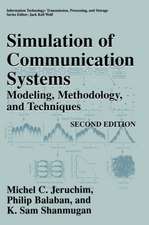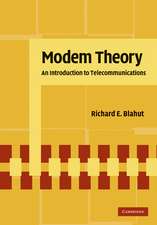Fundamentals of Resource Allocation in Wireless Networks: Theory and Algorithms: Foundations in Signal Processing, Communications and Networking, cartea 3
Autor Slawomir Stanczak, Marcin Wiczanowski, Holger Bocheen Limba Engleză Paperback – 29 noi 2011
| Toate formatele și edițiile | Preț | Express |
|---|---|---|
| Paperback (1) | 648.24 lei 6-8 săpt. | |
| Springer Berlin, Heidelberg – 29 noi 2011 | 648.24 lei 6-8 săpt. | |
| Hardback (1) | 654.62 lei 6-8 săpt. | |
| Springer Berlin, Heidelberg – 7 iul 2009 | 654.62 lei 6-8 săpt. |
Din seria Foundations in Signal Processing, Communications and Networking
- 15%
 Preț: 642.51 lei
Preț: 642.51 lei - 20%
 Preț: 339.66 lei
Preț: 339.66 lei - 20%
 Preț: 347.91 lei
Preț: 347.91 lei - 20%
 Preț: 655.53 lei
Preț: 655.53 lei - 23%
 Preț: 649.05 lei
Preț: 649.05 lei - 15%
 Preț: 647.27 lei
Preț: 647.27 lei - 20%
 Preț: 667.10 lei
Preț: 667.10 lei - 20%
 Preț: 509.31 lei
Preț: 509.31 lei - 15%
 Preț: 647.92 lei
Preț: 647.92 lei - 20%
 Preț: 556.59 lei
Preț: 556.59 lei - 15%
 Preț: 496.99 lei
Preț: 496.99 lei - 15%
 Preț: 638.24 lei
Preț: 638.24 lei - 15%
 Preț: 635.31 lei
Preț: 635.31 lei - 15%
 Preț: 642.03 lei
Preț: 642.03 lei - 20%
 Preț: 556.90 lei
Preț: 556.90 lei - 15%
 Preț: 642.18 lei
Preț: 642.18 lei
Preț: 648.24 lei
Preț vechi: 762.64 lei
-15% Nou
Puncte Express: 972
Preț estimativ în valută:
124.05€ • 134.71$ • 104.21£
124.05€ • 134.71$ • 104.21£
Carte tipărită la comandă
Livrare economică 22 aprilie-06 mai
Preluare comenzi: 021 569.72.76
Specificații
ISBN-13: 9783642242601
ISBN-10: 364224260X
Pagini: 456
Ilustrații: I, 320 p. 30 illus.
Dimensiuni: 155 x 235 x 24 mm
Greutate: 0.64 kg
Ediția:Softcover reprint of hardcover 2nd ed. 2008
Editura: Springer Berlin, Heidelberg
Colecția Springer
Seria Foundations in Signal Processing, Communications and Networking
Locul publicării:Berlin, Heidelberg, Germany
ISBN-10: 364224260X
Pagini: 456
Ilustrații: I, 320 p. 30 illus.
Dimensiuni: 155 x 235 x 24 mm
Greutate: 0.64 kg
Ediția:Softcover reprint of hardcover 2nd ed. 2008
Editura: Springer Berlin, Heidelberg
Colecția Springer
Seria Foundations in Signal Processing, Communications and Networking
Locul publicării:Berlin, Heidelberg, Germany
Public țintă
ResearchCuprins
I Mathematical Framework.- On the Perron Root of Irreducible Matrices.- On the Positive Solution to a Linear System with Nonnegative Coefficients.- II Principles of Resource Allocation in Wireless Networks.- Network Model.- Resource Allocation Problem in Communications Networks.- III Algorithms.- Power Control Algorithms.- IV Appendices.- Some Concepts and Results from Matrix Analysis.- Some Concepts and Results from Convex Analysis.
Recenzii
From the reviews of the second edition:“In a world of ubiquitous wireless services there is constant demand for reliable and fast connections. … The book Fundamentals of Resource Allocation in Wireless Networks: Theory and Algorithms written by Stanczak, Wiczanowski, and Boche, all from Technical University of Berlin, is a great example of a book that presents such a formal analysis toolbox. … The book is well organized, and the typography is of high standard. For all engineers and scientists interested in advanced concepts in resource allocation this book is a must-read.” (Przemyslaw Pawelczak, IEEE Communications Magazine, February, 2010)
Textul de pe ultima copertă
The wireless industry is in the midst of a fundamental shift from providing voice-only services to offering customers an array of multimedia services, including a wide variety of audio, video and data communications capabilities. Future wireless networks will be integrated into every aspect of daily life, and therefore could affect our life in a magnitude similar to that of the Internet and cellular phones.
This monograph demonstrates that these emerging applications and directions require fundamental understanding on how to design and control wireless networks that lies far beyond what the currently existing theory can provide. It is shown that mathematics is the key technology to cope with central technical problems in the design of wireless networks since the complexity of the problem simply precludes the use of engineering common sense alone to identify good solutions.
The main objective of this book is to provide tools for better understanding the fundamental tradeoffs and interdependencies in wireless networks, with the goal of designing resource allocation strategies that exploit these interdependencies to achieve significant performance gains. The book consists of three largely independent parts: theory, applications and appendices. The latter contain foundational aspects to make the book more understandable to readers who are not familiar with some basic concepts and results from linear algebra and convex analysis.
This monograph demonstrates that these emerging applications and directions require fundamental understanding on how to design and control wireless networks that lies far beyond what the currently existing theory can provide. It is shown that mathematics is the key technology to cope with central technical problems in the design of wireless networks since the complexity of the problem simply precludes the use of engineering common sense alone to identify good solutions.
The main objective of this book is to provide tools for better understanding the fundamental tradeoffs and interdependencies in wireless networks, with the goal of designing resource allocation strategies that exploit these interdependencies to achieve significant performance gains. The book consists of three largely independent parts: theory, applications and appendices. The latter contain foundational aspects to make the book more understandable to readers who are not familiar with some basic concepts and results from linear algebra and convex analysis.
Caracteristici
Provides the tools for better understanding the fundamental tradeoffs and interdependencies in wireless networks Shows that mathematics is the key technology to cope with central technical problems in the design of wireless networks Includes supplementary material: sn.pub/extras
















